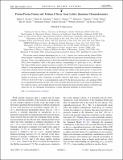| dc.contributor.author | Savage, Martin J. | |
| dc.contributor.author | Tiburzi, Brian C. | |
| dc.contributor.author | Wagman, Michael L. | |
| dc.contributor.author | Winter, Frank | |
| dc.contributor.author | Beane, Silas R. | |
| dc.contributor.author | Chang, Emmanuel | |
| dc.contributor.author | Orginos, Kostas | |
| dc.contributor.author | NPLQCD Collaboration | |
| dc.contributor.author | Shanahan, Phiala E | |
| dc.contributor.author | Davoudi, Zohreh | |
| dc.contributor.author | Detmold, William | |
| dc.date.accessioned | 2017-08-14T13:55:31Z | |
| dc.date.available | 2017-08-14T13:55:31Z | |
| dc.date.issued | 2017-08 | |
| dc.date.submitted | 2017-01 | |
| dc.identifier.issn | 0031-9007 | |
| dc.identifier.issn | 1079-7114 | |
| dc.identifier.uri | http://hdl.handle.net/1721.1/110935 | |
| dc.description.abstract | The nuclear matrix element determining the pp→de⁺ν fusion cross section and the Gamow-Teller matrix element contributing to tritium β decay are calculated with lattice quantum chromodynamics for the first time. Using a new implementation of the background field method, these quantities are calculated at the SU(3) flavor–symmetric value of the quark masses, corresponding to a pion mass of m[subscript π]∼806 MeV. The Gamow-Teller matrix element in tritium is found to be 0.979(03)(10) at these quark masses, which is within 2σ of the experimental value. Assuming that the short-distance correlated two-nucleon contributions to the matrix element (meson-exchange currents) depend only mildly on the quark masses, as seen for the analogous magnetic interactions, the calculated pp→de⁺ν transition matrix element leads to a fusion cross section at the physical quark masses that is consistent with its currently accepted value. Moreover, the leading two-nucleon axial counterterm of pionless effective field theory is determined to be L[subscript 1,A]=3.9(0.2)(1.0)(0.4)(0.9) fm³ at a renormalization scale set by the physical pion mass, also agreeing within the accepted phenomenological range. This work concretely demonstrates that weak transition amplitudes in few-nucleon systems can be studied directly from the fundamental quark and gluon degrees of freedom and opens the way for subsequent investigations of many important quantities in nuclear physics. | en_US |
| dc.description.sponsorship | National Science Foundation (U.S.) (PHY11-25915) | en_US |
| dc.publisher | American Physical Society | en_US |
| dc.relation.isversionof | http://dx.doi.org/10.1103/PhysRevLett.119.062002 | en_US |
| dc.rights | Article is made available in accordance with the publisher's policy and may be subject to US copyright law. Please refer to the publisher's site for terms of use. | en_US |
| dc.source | American Physical Society | en_US |
| dc.title | Proton-Proton Fusion and Tritium β Decay from Lattice Quantum Chromodynamics | en_US |
| dc.type | Article | en_US |
| dc.identifier.citation | Savage, Martin J. et al. "Proton-Proton Fusion and Tritium β Decay from Lattice Quantum Chromodynamics." Physical Review Letters 119, 6: 062002 © 2017 American Physical Society | en_US |
| dc.contributor.department | Massachusetts Institute of Technology. Center for Theoretical Physics | en_US |
| dc.contributor.department | Massachusetts Institute of Technology. Department of Physics | en_US |
| dc.contributor.department | Massachusetts Institute of Technology. Laboratory for Nuclear Science | en_US |
| dc.contributor.mitauthor | Shanahan, Phiala E | |
| dc.contributor.mitauthor | Davoudi, Zohreh | |
| dc.contributor.mitauthor | Detmold, William | |
| dc.relation.journal | Physical Review Letters | en_US |
| dc.eprint.version | Final published version | en_US |
| dc.type.uri | http://purl.org/eprint/type/JournalArticle | en_US |
| eprint.status | http://purl.org/eprint/status/PeerReviewed | en_US |
| dc.date.updated | 2017-08-10T22:00:02Z | |
| dc.language.rfc3066 | en | |
| dc.rights.holder | American Physical Society | |
| dspace.orderedauthors | Savage, Martin J.; Shanahan, Phiala E.; Tiburzi, Brian C.; Wagman, Michael L.; Winter, Frank; Beane, Silas R.; Chang, Emmanuel; Davoudi, Zohreh; Detmold, William; Orginos, Kostas | en_US |
| dspace.embargo.terms | N | en_US |
| dc.identifier.orcid | https://orcid.org/0000-0002-1110-3633 | |
| dc.identifier.orcid | https://orcid.org/0000-0002-0400-8363 | |
| mit.license | PUBLISHER_POLICY | en_US |
